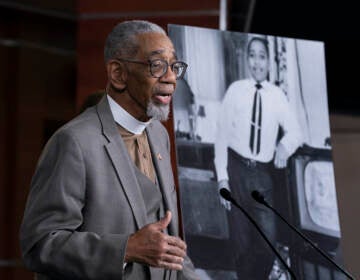This white chocolate martini does not mean what you think it means
It wasn't until eight years later that my husband and I realized the pun: a white bride and black groom. We felt a little embarrassed by the unintended joke.

the author and her husband sip white chocolate martinis at Bok Bar in South Philadelphia, overlooking the Center City skyline. (@PhillyBlooms)
This year marks the 50th anniversary of Loving v. Virginia, the U.S. Supreme Court case that overturned state laws banning interracial marriage. Over five decades, interracial relationships have become more common across the United States, but those couples still face some unique challenges.
Inspired by “The Loving Project,” a podcast featuring the stories of mixed-race couples, we are asking readers to submit essays about their own experiences.
—
The signature cocktail at my wedding was a white chocolate martini. We chose it because it was easy to make — and tasty. Just some liquor and some half and half. You can make it even fancier by adding a little cocoa and a Hershey’s kiss. We thought the drink would be the perfect touch.
It wasn’t until eight years later, while recording an episode of the podcast “The Loving Project,” that my husband and I realized the pun: a white bride and black groom had a white (and) chocolate martini at their wedding. How cheesy! We could have chosen it as an intentional symbol of unity, a blending of families, or a self-effacing joke. But the thought had quite frankly never occurred to us. It was simply our favorite drink, and we felt a little embarrassed by the unintended joke.
This funny, if a little awkward, moment was certainly not the first time in our lives that race had given an action a meaning different from its original intent. Race is always present in an interracial marriage, even in the moments you forget to look for it. It pops up when life is otherwise perfectly ordinary.
Sometimes I’m chatting with my spouse, deciding which line is the shortest at the grocery store, and an employee will direct me to cashier 9 and him to cashier 10. In that moment, I remember that we look visibly different, like we don’t “belong” together. When, like most couples, we’re arguing at home about who forgot to buy toilet paper, race is not at the forefront of my mind. In our lives, race is both obscure and, when you’re looking for it, obvious — like the accidental pun of the white chocolate martini.
I’m thankful that, in 2017, ordinariness is often the status quo for many interracial couples. Yet, racism continues to punctuate our daily lives. And there are particular ways that, as a white person in an interracial couple, one gets an inside peek at the subtle and overt ways non-white people live with racism all the time.
I could write here about the times that my husband was called the “n” word while we were walking together, or about the older (always white) relatives we decided not to invite to our wedding. Those are the obvious moments.
But there are far more subtle issues — and these moments can serve as lessons for those who don’t think often about racism’s stubborn presence. Take, for example, a few years ago, when my husband and I applied to rent a condo. The condo owner phoned our previous landlord, asking far more questions about my husband’s “character” than mine. Our landlord advised us not to rent from her. We didn’t.
And then there are the more uncomfortable moments when, as a person perceived as white and not expected to have a black family, you get to be “in” on the game. Like when an acquaintance says, “Oh, it was a black neighborhood” and expects you to interpret that as “it was poor or unsafe” without calling them out on the association. Or like the doctor who asked me to schedule a visit on Martin Luther King, Jr. Day. “Isn’t that a holiday?” I asked. “Oh, it’s not an important one,” she replied. Standing in her office, holding one hand on my pregnant belly, I cancelled the appointment and did not return.
If racism were limited to hurling epithets, it might seem easier to combat — like explaining that the white martini is not, in fact, vanilla. Yet, under the guise of the ordinary, racism thrives. If there is anything that this current political moment has taught us, it is that we are far from free of racism’s devastating effects. The unanticipated ways that racism plays a role in my life reminds me constantly of the work yet to be done.
Ultimately, though, my story is one of love — of falling madly in love with a kind and intelligent man for whom I am thankful every day. And we both believe strongly that love does triumph. Being in an interracial marriage 50 years after Loving v. Virginia is both ordinary and not. In the ways that it is not yet ordinary, it reveals the persistence of race’s influence on our expectations.
Because of those who actively challenge these expectations, my husband and I have seen the potent flavor of love overpower racism. Just like our shared delight in the white chocolate martini’s flavor overpowered the drink’s potential symbolism.
The white cocktail’s chocolate flavor is a surprise indeed, and there is power in surprise. To those who perceive me as a white woman and expect me to live in a near homogeneously white world, my interracial family is a surprise. I find that this reaction can often challenge people to alter their expectations and decrease their bias, which, on my most optimistic days, I hope will lead to a brighter future — one to which we can all raise a glass.
—
Lesley Curtis, Ph.D., is the founder of Sagely, a communications company. She lives in Philadelphia with her husband and daughter. She and her husband are featured in episode 16 of the podcast “The Loving Project.”
WHYY is your source for fact-based, in-depth journalism and information. As a nonprofit organization, we rely on financial support from readers like you. Please give today.




